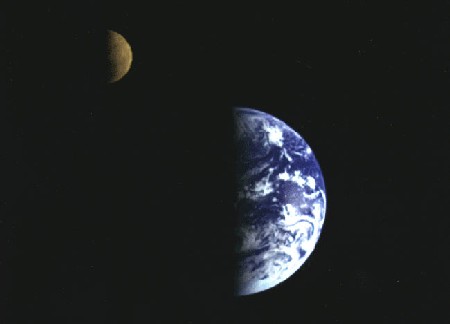
There is disagreement among astrobiologists about whether advanced life is common or rare in the universe. New research suggests that one thing is relatively certain - if an Earth-like world with a disciplined amount of water is necessary for the development of advanced life, there may be many candidates.
In 44 computer simulations of the formation of planets near the Sun, astronomers found that each simulation yielded between one and four terrestrial planets, and among them 11 habitable planets at about the same distance from their Sun as the Earth's distance from the Sun.
"Our imaging shows a wide variety of planets. You can have very dry planets like Mars, which are about half the size of Earth, or planets like Earth or even ones that are three times the size of Earth and have ten times as much water as Earth," said Sean Raymond, a doctoral student in astronomy at the University of Washington.
Raymond is the lead author of a paper detailing the results of the simulations. The article has been accepted for publication in Icarus, the journal of the Planetary Sciences Division of the American Astronomical Society. Co-authors are Thomas R. Cain, associate professor of astronomy at the University of Washington, and Jonathan Lunin, professor of planetary sciences and physics at the University of Arizona.
The simulations show that the amount of water on terrestrial planets may be largely influenced by external gaseous giants such as Jupiter.
"The more giant planets there are in non-circular orbits, the drier the terrestrial planets will be," Raymond said. "And conversely, as the orbits of the giant planets are more circular, the terrestrial planets will be more abundant with water."
In the case of the solar system, Jupiter's orbit is slightly elliptical, which could explain why 80% of Earth is covered in water and not all wet and covered in miles of water.
The results are important because of the discovery of a large number of giant planets such as Jupiter and Saturn around other suns in recent years. The existence and orbits of these planets can be inferred from their gravitational effects on their star and their effects on the light coming from the star as seen from Earth.
Currently, the discovery of terrestrial planets is not possible. However, if the results of the simulations are correct, there may be Earth-like planets around other stars relatively close to our solar system. It is likely that a considerable number of these planets are in the "belt of life", in the region where the distance from the sun allows the existence of liquid water on the surface.
Liquid water is considered a basic requirement for life, therefore planets in the "life belt" of a star are prime candidates for sustaining life. However, it is not clear whether these planets are capable of containing more than simple microbial soup of life.
The researchers point out that the simulations represent the possible extreme states of planet formation, and not the typical state of the planets in our galaxy. Currently, the researchers said, it is not clear which of the approaches is more realistic.
The researchers' goal is to understand what the terrestrial planets in the system would look like, if the characteristics of the giant planets in it are known, Raymond said.
Keen pointed out that the orbits of all the giant planets that have been discovered so far are very close to the star they orbit, so that the gas giants complete a revolution around the star in relatively short times, which makes viewing them easier. The giant planets probably formed further away from their sun, but due to gravitational forces migrated closer.
However, Cain predicts that giant planets will begin to appear in orbits farther from their sun, when astronomers will have more time to observe them and the gravitational forces in the longer orbits. He doubts that they will be discovered at stages where they have not yet completed their migration, as their trajectories will be too strange to identify them with certainty.
"These simulations take place after the migration has ended, after the giant planet's orbit has stabilized," he said.
The research was supported by the National Aeronautics and Space Administration's Astrobiology Institute, its Planetary Atmosphere Program, and the Intel Corporation.
